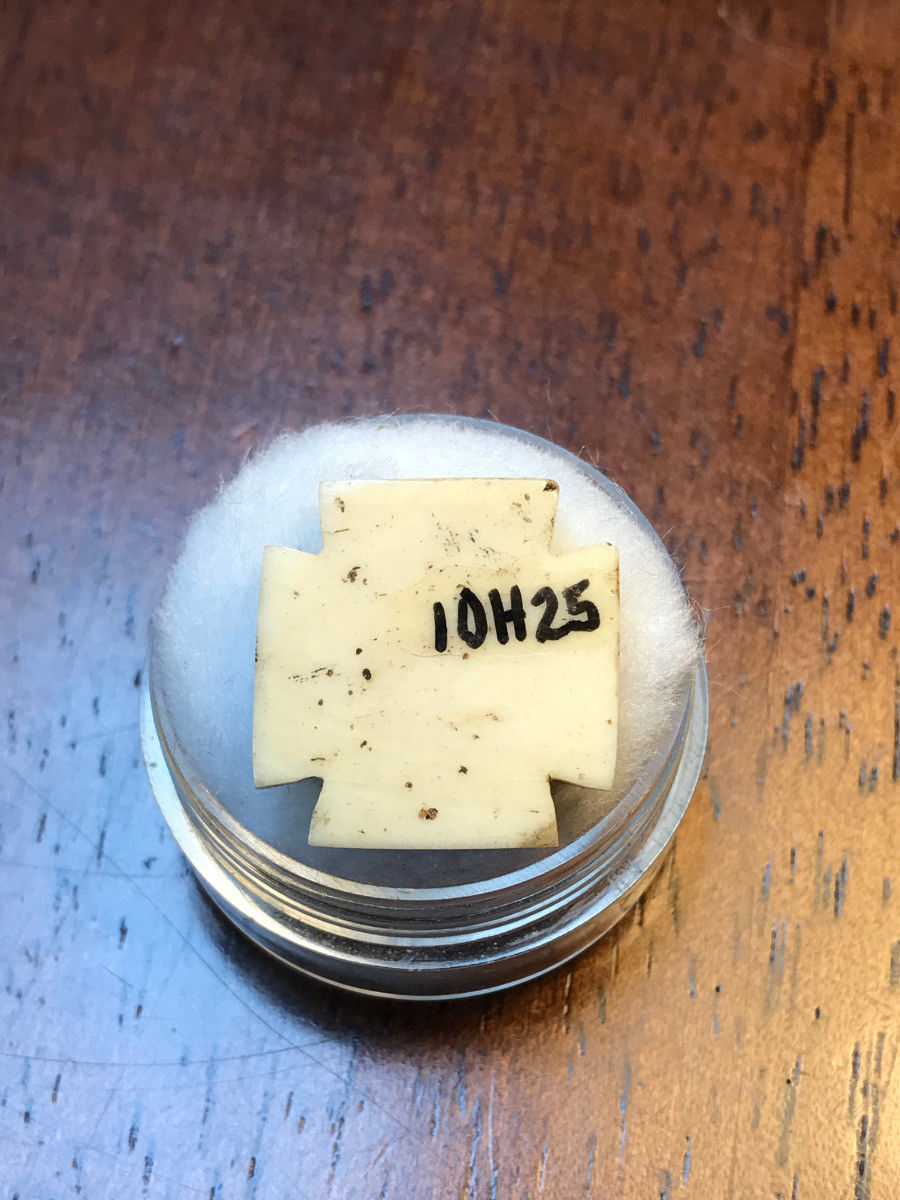William C. Oakman Co. C. 35th Massachusetts Identification Badge



Fantastic Union Civil War identification badge of William C. Oakman of Co. C. 35th Massachusetts Infantry. It was field carved out of steer bone into a cross design. It is carved, then infilled with red wax, around the four sides, W. C. O. Co. - C / 2 DIV. / 2 BRIG. / 35 MASS. In the center is a large 9 for 9th corps. William Oakman was wounded on 9/30/1864 at Popular Springs Church, Va. He was taken a POW, prisoner of war. He died of wounds a POW on 10/6/1864. This badge was part of the Norm Flayderman collection and has his inventory number on the back. It measures app. 22 x 22 mm's in size. It has a nice mellow aged patina. The following is the information listed for William in the Civil War database I pay for: William C. Oakman Residence Chelsea MA; a 31 year-old Ship Carpenter. Enlisted on 7/21/1862 as a Private. On 8/18/1862 he mustered into "C" Co. MA 35th Infantry He died wounds POW on 10/6/1864 He was listed as: * POW 9/30/1864 Poplar Springs Church, VA * Wounded 9/30/1864 Poplar Springs Church, VA This is the history listed for the 35th Massachusetts infantry: THIRTY-FIFTH REGIMENT MASSACHUSETTS VOLUNTEER INFANTRY THREE YEARS The 35th Regt. Mass. Vol. Inf. was organized at Camp Stanton, Lynnfield, and was composed mostly of men enrolled in eastern Massachusetts. It was recruited during July and the early part of August, 1862, and its members were mustered into the service largely between August 9 and 19. Under Col. Edward A. Wild the regiment left for the seat of war August 22, reaching B. Washington on the 24th. On Sept. 8, it was assigned to Ferrero's (2d) Brigade, Sturgis' (2d) Division, Reno's (9th) Corps. Joining the Army of the Potomac it took part in the battle of South Mountain, Sept. 14, 1862, where Col. Wild lost his left arm. At Antietam, Sept. 17, under command of Lieut. Col. Carruth, the regiment lost 214 officers and men, of whom 69 were killed or mortally wounded. At Fredericksburg, Dec. 13, 1862, it again suffered severely, losing Major Willard, who was in command. It camped during the early part of the winter near Falmouth. On Feb. 9, 1863, it was transferred to Newport News, Va., and, after a few weeks stay at this place, was sent with the 9th Corps into Kentucky, being stationed at Mount Stirling, Lancaster, Stanford, and other places. Lieut. Col. Carruth now became colonel of the regiment. It was next ordered to Vicksburg, Miss., to reinforce Gen. Grant, remaining about four weeks, until the surrender of the city, July 4. It participated in the pursuit of Johnston's army to Jackson, Miss., and was present at the capture of the city, then returned to its old camp near Vicksburg. From here it proceeded by boat and train to Cincinnati, reaching there the 14th of August. Proceeding to Knoxville, Tenn., which it reached Oct. 22, it participated in the defense of the city against Longstreet. After the close of the siege, Dec. 4, the 35th soon proceeded to Blain's Cross Roads, where it remained, enduring great privations, until January, 1864. After various movements -to Knoxville, Morristown, and elsewhere- the regiment returned to Cincinnati. Here, April 1, it entrained for Baltimore, Md., from whence it took boat for Annapolis. In the reorganization of the 9th Corps the regiment, now commanded by Major Nat Wales, became a part of Carruth's (1st) Brigade, Stevenson's (1st) Division. During the battle of the Wilderness, May 5 and 6, and the first part of that of Spottsylvania, May 8 to 12, the 35th was in charge of the supply train of the 1st Division, and was not engaged. Returning to its brigade, May 17, on the following day it was in the last assault on the Confederate lines at Spottsylvania, moving thence to the North Anna River, where it was again engaged, May 25. It was now detailed as an engineer corps for the 1st Division. At Cold Harbor, June 3, it was posted near Bethesda Church and suffered light loss. Crossing the James on June 15, the regiment participated in the siege of Petersburg. At the Crater fight, July 30, it was heavily engaged, losing 12 killed and 34 wounded. At Weldon Railroad, Aug. 19, it was again engaged with loss. It was now reduced to two officers and about 100 men present for duty. In another reorganization of the 9th Corps early in September it was assigned to Curtin's (1st) Brigade, Potter's (2d) Division. About this time there were added to the regiment 385 German and French substitutes, recently arrived in this country and ignorant of the English tongue. Major Hudson now commanded the regiment. At Poplar Spring Church, Sept. 30, it was severely engaged, losing 163 prisoners. For two months it was now posted near Forts Fisher and Welsh. During the midwinter it was stationed in the rear of Fort Sedgwick (Fort Hell). From March 7, 1865, until the fall of Petersburg, April 2, it formed a part of the garrison of this fort. It then joined in the pursuit of Lee's army and was at Farmville when the news came of the surrender. Arriving at Alexandria, Va., April 28, it remained as a part of the garrison of the District of Columbia until June 9, when it transferred its recruits to the 29th Regiment and was mustered out of the service. Returning to Readville, Mass., on June 27, the men were paid off and discharged. $425